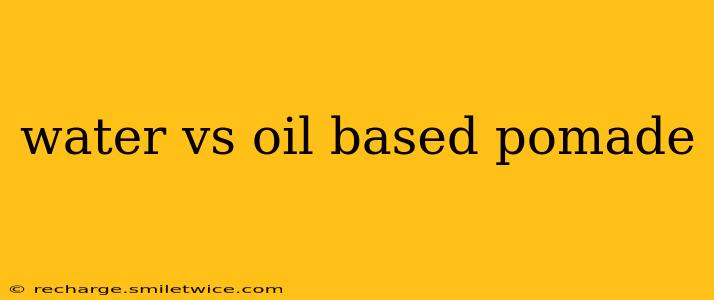Choosing the right pomade can significantly impact your hairstyle and overall grooming experience. The battle of the pomades often comes down to one key difference: their base. This comprehensive guide will delve into the distinctions between water-based and oil-based pomades, helping you decide which is best for your hair type, style, and lifestyle.
What is the Difference Between Water-Based and Oil-Based Pomade?
The fundamental difference lies in their, well, base. Water-based pomades use water as their primary solvent, while oil-based pomades utilize oils like petroleum, mineral oil, or lanolin. This seemingly simple difference leads to a cascade of variations in texture, hold, shine, and ease of washout.
Water-Based Pomade: Pros and Cons
Pros:
- Easy to wash out: This is the biggest advantage. Water-based pomades wash out easily with just water and shampoo, eliminating the need for harsh solvents or multiple washes.
- Lightweight feel: They generally feel lighter in the hair, offering a less greasy feel.
- Good for everyday use: Their easy wash-out feature makes them ideal for daily styling.
- Versatile hold: While typically offering a medium hold, many water-based pomades now offer strong holds suitable for various styles.
- Often less expensive: Generally, water-based pomades are more affordable than their oil-based counterparts.
Cons:
- Can dry out hair: Some individuals find that water-based pomades can be slightly drying, particularly for those with already dry hair.
- Less shine: They generally offer less shine compared to oil-based pomades.
- May not hold as strongly: While high-hold water-based pomades exist, they might not offer the same level of strong hold as oil-based options.
Oil-Based Pomade: Pros and Cons
Pros:
- Strong hold: Oil-based pomades provide a remarkably strong hold, perfect for complex styles that require all-day staying power.
- High shine: These pomades deliver a classic, high-shine finish, ideal for slicked-back styles or pompadours.
- Buildable: You can layer oil-based pomade to achieve the desired level of hold and shine.
- Nourishes hair: The oils in the pomade can condition and nourish the hair, adding moisture and shine.
Cons:
- Difficult to wash out: This is their main drawback. They require special shampoos or multiple washes to remove completely.
- Greasy feel: They can leave the hair feeling greasy or heavy, especially if applied excessively.
- Not ideal for daily use: The difficulty of washing them out makes them less suitable for everyday use.
- Can build up: If not washed out thoroughly, residue can build up on the scalp and hair, potentially leading to irritation or clogged pores.
Which Type of Pomade is Right for Me?
The best pomade depends entirely on your individual needs and preferences:
- For daily use and easy washout: Water-based pomades are the clear winner.
- For strong hold and high shine: Oil-based pomades offer superior hold and a classic look.
- For fine or dry hair: Be cautious with water-based pomades, as they can be drying. Consider an oil-based pomade, but use sparingly and ensure thorough washing.
- For thick or coarse hair: Both types can work, but oil-based might provide better control.
How to Apply Pomade (Both Types)
Regardless of the type, the application process is similar:
- Start with clean, dry or slightly damp hair. Damp hair provides better control for some styles.
- Take a small amount of pomade. Start with a pea-sized amount and add more if needed.
- Rub the pomade between your palms to warm it up and soften it.
- Apply the pomade evenly to your hair, starting from the roots and working your way to the ends.
- Style your hair as desired. Use a comb or your fingers to create your desired look.
What are the different types of hold available in water-based and oil-based pomades?
Both water-based and oil-based pomades are available in varying holds, ranging from light to extra strong. The specific hold strength will depend on the brand and formulation. Look for descriptions on the product packaging to determine the hold strength – often described as light, medium, strong, or extra strong. Read reviews to gauge the actual hold experienced by other users.
Can I mix water-based and oil-based pomades?
While not strictly recommended, it's technically possible to mix water-based and oil-based pomades. However, this can affect the texture, hold, and shine, potentially resulting in an inconsistent finish. It’s best to experiment cautiously and start with a tiny amount of each to see how they combine.
Is it bad to use pomade every day?
Daily use of pomade depends on the type and your hair type. Water-based pomades are generally better suited for daily use because of their easy wash-out properties. However, excessive daily use of any pomade, even water-based, could potentially lead to product buildup or dryness, depending on your hair. Always ensure thorough washing and consider taking breaks if you notice any negative effects.
By understanding the differences between water-based and oil-based pomades, you can make an informed decision and achieve the perfect hairstyle for your hair type and lifestyle. Remember to always read product descriptions and reviews before making a purchase.
